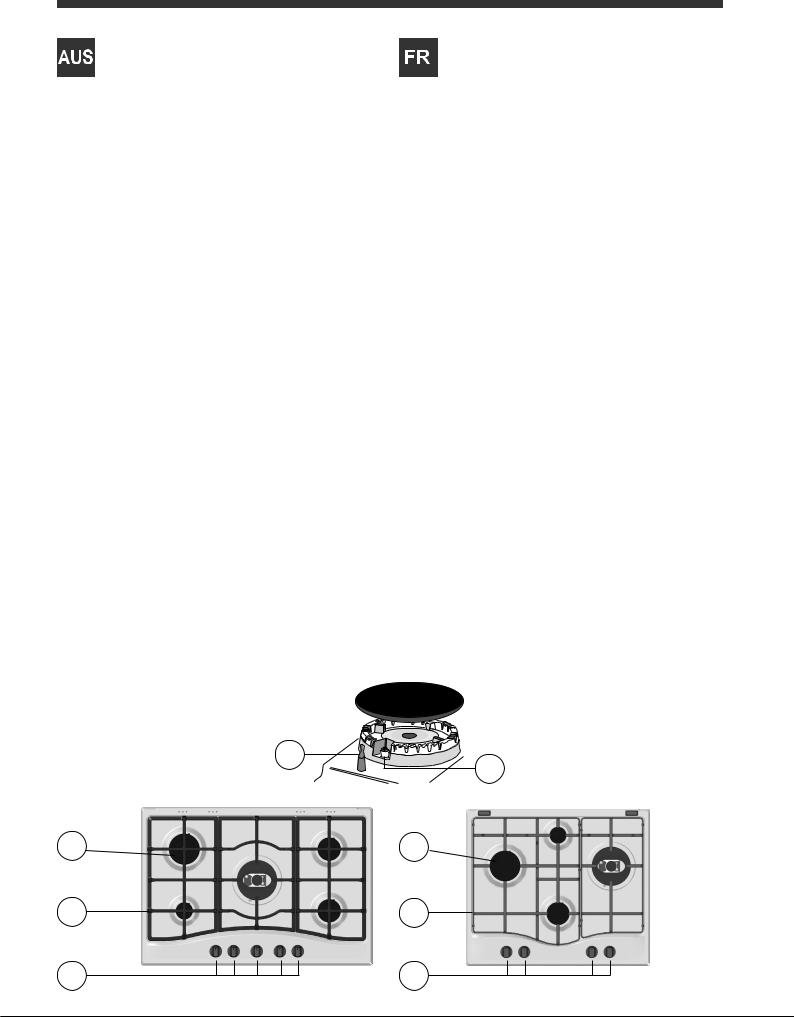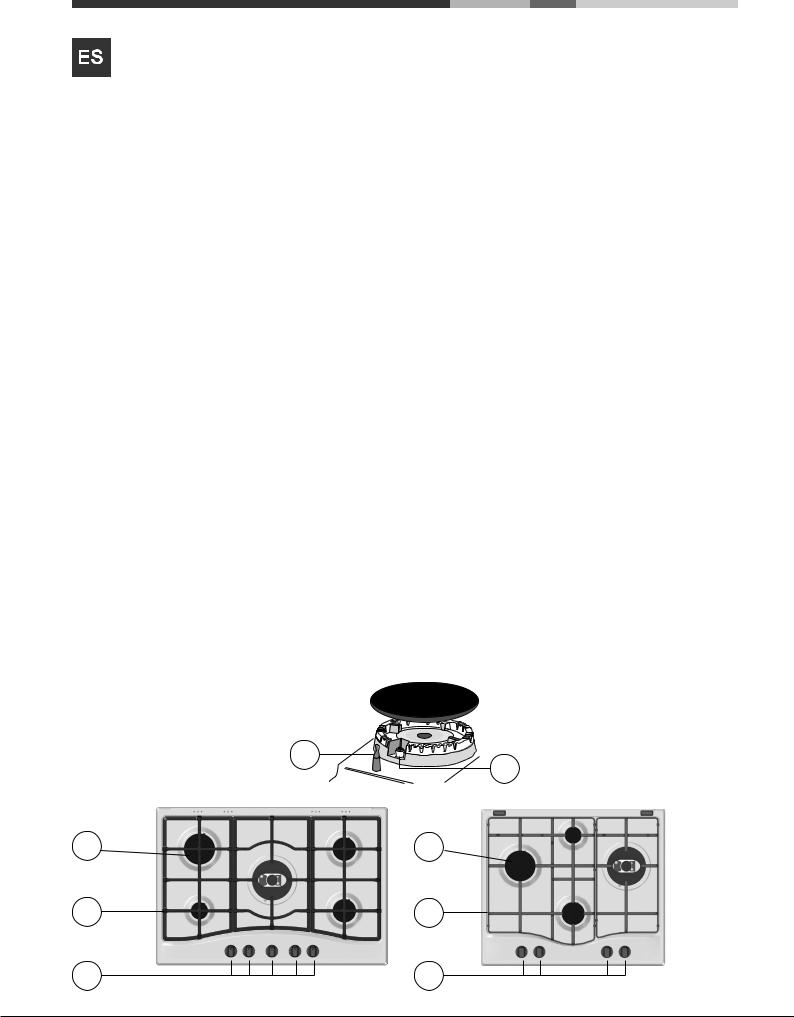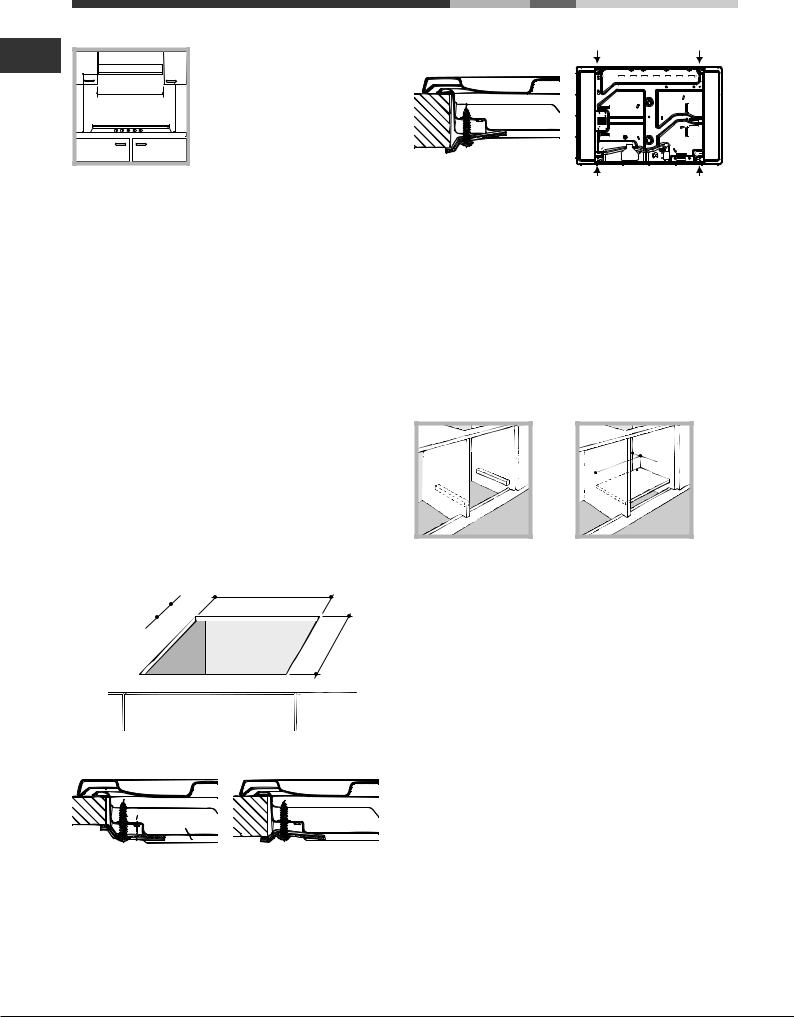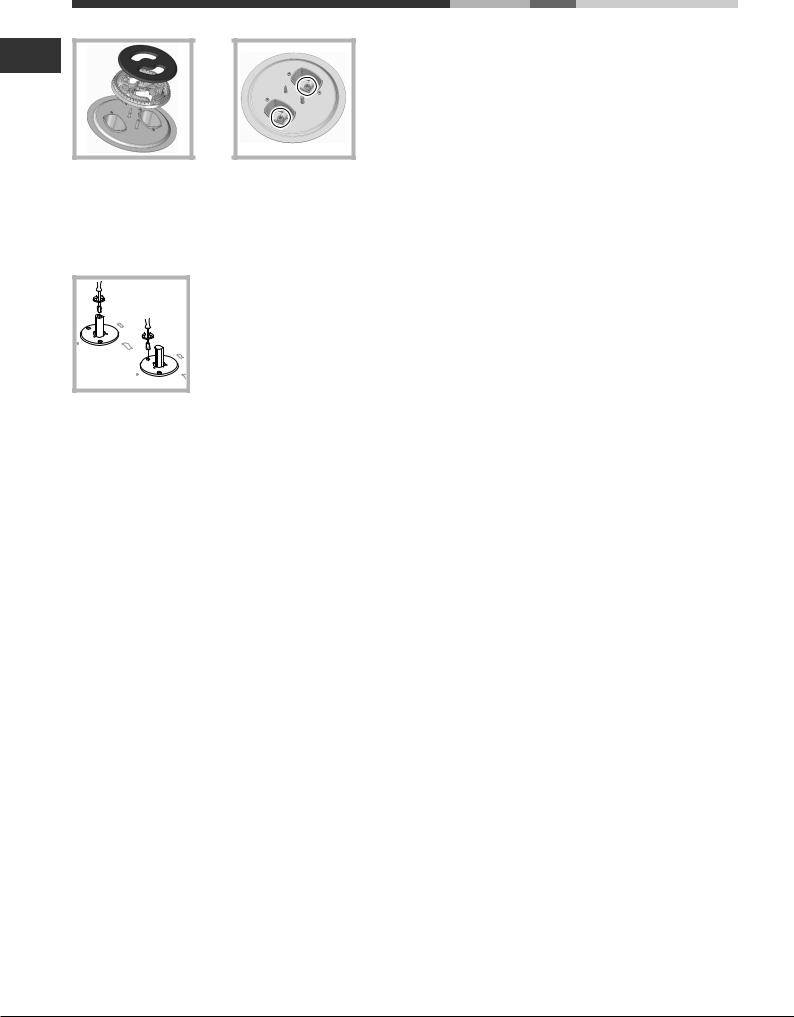Hotpoint PC 640 T X AUS, PC 640 N T X AUS, PC 750 T GH AUS Manual

PC 640 T X AUS
PC 640 N T X AUS
PC 750 T GH AUS
 Español
Español
Manual de instrucciones
ENCIMERA Sumario
Manual de instrucciones,1
Advertencias,3
Asistencia,4
Descripción del aparato,6
Instalación,22
Puesta en funcionamiento y uso,27
Precauciones y consejos,27
Mantenimiento y cuidados,28
Anomalías y soluciones,29
 English
English
Operating Instructions
HOB Contents
Operating Instructions,1
Warnings,2
Assistance,4
Description of the appliance,5
Start-up and use,12
Precautions and tips,12
Maintenance and care,13
Troubleshooting,13
 Français
Français
Mode d’emploi
TABLE DE CUISSON
Sommaire
Mode d’emploi,1
Avertissements,2
Assistance,4
Description de l’appareil,5
Installation,14
Mise en marche et utilisation,19
Précautions et conseils,19
Nettoyage et entretien,20
Anomalies et remèdes,21

Warnings
WARNING: The appliance and its accessible parts become hot during use. Care should be taken to avoid touching heating elements. Children less than 8 years of age shall be kept away unless continuously supervised. This appliance can be used by children aged from 8 years and above and persons with reduced physical, sensory or mental capabilities or lack of experience and knowledge if they have been given supervision or instruction concerning use of the appliance in a safe way and understand the hazards involved. Children shall not play with the appliance. Cleaning and user maintenance shall not be made by children without supervision.
WARNING: Unattended cooking on a hob with fat or oil can be dangerous and may result in fire. NEVER try to extinguish a firewithwater,butswitchofftheappliance and then cover flame e.g. with a lid or a fire blanket.
WARNING: Danger of fire: do not store items on the cooking surfaces.
Never use steam cleaners or pressure cleaners on the appliance.
Remove any liquid from the lid before opening it. Do not close the glass cover (if present) when the gas burners or electric hotplates are still hot.
The appliance is not intended to be operated by means of an external timer or separate remote control system.
CAUTION: the use of inappropriate hob
guards can cause accidents.
Avertissements
ATTENTION : Cet appareil ainsi que ses parties accessibles deviennent très chauds pendant leur fonctionnement. Il faut faire attention à ne pas toucher les éléments chauffants. Ne pas faire approcher les enfants de moins de 8 ans à moins qu’ils ne soient sous surveillance constante. Le présent appareil peut être utilisé par des enfants de plus de 8 ans et par des personnes présentant des capacités physiques, sensorielles ou mentales réduites ou n’ayant pas l’expérience ou les connaissances indispensables, à condition qu’ils soient sous bonne surveillance ou qu’ils aient reçu les instructions nécessaires pour une utilisation de l’appareil en toute sécurité et à condition qu’ils se rendent compte des dangers encourus. Les enfants ne doivent pas jouer avec l’appareil. Les opérations de nettoyage et d’entretien ne doivent pas être effectuées par des enfants non surveillés.
ATTENTION : Laisser un récipient de cuisson avec de l’huile ou de la graisse sur un foyer est dangereux et risque d’entraîner un incendie. Il ne faut JAMAIS essayer d’éteindreuneflammeouunincendieavec de l’eau ! Il faut éteindre l’appareil et couvrir laflammeavecuncouvercle,parexemple, ou avec une couverture anti-feu.
ATTENTION : Risque d’incendie : ne pas laisser d’objets sur les surfaces de cuisson.
Ne jamais nettoyer l’appareil avec des nettoyeurs vapeur ou haute pression.
2

Essuyer tout liquide pouvant se trouver sur le couvercle avant de l’ouvrir. Ne pas abaisser le couvercle en verre (s’il y en a un) tant que les brûleurs gaz ou la plaque électrique sont chauds.
Cet appareil ne peut pas être allumé au moyen d’un temporisateur extérieur ou d’un système de commande à distance séparé.
ATTENTION : l’utilisation de protections de table inappropriées peut causer des incendies.
ATENCIÓN: Riesgo de incendio: no deje objetos sobre las superficies de cocción.
No utilice nunca limpiadores a vapor o de alta presión para la limpieza del aparato.
Elimine eventuales líquidos presentes sobre la tapa antes de abrirla. No cierre la tapa de vidrio (si existe) cuando los quemadores o la placa eléctrica todavía están calientes.
El aparato no se debe poner en funcionamiento a través de un temporizador externo o de un sistema de mando a distancia.
Advertencias
ATENCIÓN: Este aparato y sus partes accesibles se vuelven muy calientes durante el uso. Por lo tanto, es importante evitar tocar los elementos calentadores. Mantenga alejados a los niños menores de 8 años si no son continuamente vigilados. Elpresenteaparatopuedeser utilizado por niños mayores de 8 años y por personas con capacidades físicas, sensoriales o mentales disminuidas o sin experiencia ni conocimientos, si se encuentran bajo una adecuada vigilancia o si han sido instruidos sobre el uso del aparato de modo seguro y comprenden los peligros relacionados con el mismo. Los niños no deben jugar con el aparato. Las operaciones de limpieza y de mantenimiento no deben ser realizadas por niños sin vigilancia.
ATENCIÓN: Dejar un quemador con grasas o aceites sin vigilancia puede ser peligroso y provocar un incendio. NUNCA intente apagar una llama/incendio con agua, se debe apagar el aparato y cubrir la llama, por ejemplo, con una tapa o con una manta ignífuga.
ATENCIÓN: el uso de protecciones inapropiadas de la placa de cocción puede provocar accidentes.
3

Assistance
Communicating:
•appliance model (Mod.)
•serial number (S/N)
This information is found on the data plate located on the appliance and/or on the packaging.
! Never use unauthorised technicians and never accept replacement parts which are not original.
Assistance
Indiquez-lui :
•le modèle de votre appareil (Mod.)
•son numéro de série (S/N)
Ces informations figurent sur la plaquette signalétique apposée sur votre appareil et/ou sur son emballage.
! Ne faites jamais appel à des techniciens non agréés et refusez toujours l’installation de pièces détachées non originales.
ARISTON
PRIORITY SERVICE
If you are not completely satis ed with your appliance or require service call:
Australia
Phone: 1300 815 589
New Zealand
Phone: (09) 306 1020
AUSTRALIA
ARISIT PTY LIMITED
40-44 Mark Anthony Drive, Dandenong South,
VIC 3175, Australia
Fax: Service & Sales (03) 9768 0838
Email: consumer.care@arisit.com
Asistencia
Comunique:
•el modelo de la máquina (Mod.)
•el número de serie (S/N)
Estainformaciónseencuentraenlaplacadecaracterísticas ubicada en el aparato y/o en el embalaje.
! No recurra nunca a técnicos no autorizados y rechace siempre la instalación de repuestos no originales.
La siguiente información es válida solo para España. Para otros países de habla hispana consulte a su vendedor.
Ampliación de garantía
Llame al 902.363.539 y le informaremos sobre el fantástico plan de ampliación de garantía hasta 5 años.
Consiga una cobertura total adicional de
•Piezas y componentes
•Mano de obra de los técnicos
•Desplazamiento a su domicilio de los técnicos
Y NO PAGUE AVERIAS NUNCA MAS
Servicio de asistencia técnica (SAT)
Llame al 902.133.133 y nuestros técnicos intervendrán con rapidez y eficacia, devolviendo el electrodoméstico a sus condiciones óptimas de funcionamiento.
En el SAT encontrará recambios, accesorios y productos específicos para la limpieza y mantenimiento de su electrodoméstico a precios competitivos.
ESTAMOS A SU SERVICIO
GENUINE ACCESSORIES
& SPARE PARTS
A wide range of genuine accessories are available for your appliance call:
Australia
Phone: 03 9768 0888
New Zealand
Phone: (09) 306 1020
NEW ZEALAND
ARISIT PTY LIMITED
PO Box 68-140 Newton, Auckland
1145, New Zealand
Fax: (09) 302 0077
Email: sales@aristonappliances.co.nz
4

Description of the appliance
Overall view
1.Support Grid for COOKWARE
2.GAS BURNERS
3.Control Knobs for GAS BURNERS
4.Ignition for GAS BURNERS*
5.SAFETY DEVICES*
•GAS BURNERS differ in size and power. Use the diameter of the cookware to choose the most appropriate burner to cook with.
•Control Knobs for GAS BURNERS adjust the size of the flame.
•GAS BURNER IGNITION* enables a specific burner to be lit automatically.
•SAFETY DEVICE* stops the gas flow if the flame is accidentally extinguished.
* Only available on certain models.
Description de l’appareil
Vue d’ensemble
1.Grilles support de CASSEROLES
2.BRÛLEURS À GAZ
3.Manettes de commande des BRÛLEURS GAZ
4.Bougie d’allumage des BRÛLEURS GAZ*
5.DISPOSITIF DE SÉCURITÉ*
•BRÛLEURS GAZ ils ont plusieurs dimensions et puissances. Choisissez celui qui correspond le mieux au diamètre de votre casserole.
•Manettes de commande des BRÛLEURS GAZ pour le réglage de la flamme.
•La bougie d’allumage des BRÛLEURS GAZ* permet l’allumage automatique du brûleur sélectionné.
•DISPOSITIFDE SÉCURITÉ* en cas d’extinction accidentelle de la flamme, coupez immédiatement l’arrivée du gaz.
* N’existe que sur certains modèles.
|
5 |
4 |
|
|
|
2 |
|
2 |
1 |
|
1 |
3 |
|
3 |
5

Descripción del aparato
Vista en conjunto
1.Parrillas de apoyo para RECIPIENTES DE COCCIÓN
2.QUEMADORES A GAS
3.Mandos de los QUEMADORES A GAS
4.Bujía de encendido de los QUEMADORES A GAS*
5.DISPOSITIVO DE SEGURIDAD*
•QUEMADORES A GAS: son de distintas dimensiones y potencias. Elija siempre el más adecuado para el diámetro del recipiente que va a utilizar.
•MandosdelosQUEMADORES A GAS para la regulación de la llama.
•Bujía de encendido de los QUEMADORES A GAS:* permite el encendido automático del quemador.
•DISPOSITIVO DE SEGURIDAD:* si se apaga accidentalmente la llama, interrumpe la salida de gas.
* Presente sólo en algunos modelos.
|
5 |
4 |
|
|
|
2 |
|
2 |
1 |
|
1 |
3 |
|
3 |
6

Installation
!Before operating your new appliance please read this instruction booklet carefully. It contains important information for safe use, installation and care of the appliance.
!Please keep these operating instructions for future reference. Pass them on to possible new owners of the appliance.
Compliance with standards
This cooktop must be installed in accordance with the requirements of local gas and electrical authorities, as well as the latest published versions of the following standards:
•AS/NZS 5601 Gas Installation code
•SAA Wiring Rules.
Positioning
!Keep packaging material out of the reach of children. It can become a choking or suffocation hazard (see Precautions and tips).
!The appliance must be installed by a qualified professional according to the instructions provided. Incorrect installation may cause harm to people and animals or may damage property.
Kitchen Ventilation
Where the total input of all appliances exceeds 3 MJ/h for each cubic metre of the room or enclosure volume, the space shall be ventilated by one of the methods detailed below. For the purpose of assessing the adequacy of ventilation, the space that cannot be isolated by doors is the ‘volume of a room’.
Natural ventilation direct from outside
Two permanent openings shall be provided directly to outside. The openings shall be located to ensure the distance between the top of the upper opening and the ceiling of the room or enclosure, and the distance between the bottom of the lower opening and the floor of the room or enclosure does not exceed 5% of the height of the room or enclosure. The minimum free ventilation area provided by each opening shall be calculated using the following formula:
A = 3 × T where
A = the minimum free ventilation area (cm2)
T = the total gas consumption of all appliances (MJ/h) The minimum vertical dimension of any free ventilation opening shall be 6 mm.
NOTE 1 When used in this Clause, the term ‘directly to outside’ means any one of the following options, provided that the ventilation path is unobstructed by building material or insulation:
(a)Directly through an outside wall (preferred option).
(b)Through to an outside wall but offset.
(c)Into a cavity ventilated to outside.
(d)Into an under floor space ventilated to outside.
(e)Into a roof space ventilated to outside.
NOTE 2 The two openings may be combined provided that the top and bottom of the opening reach the limits set by this Clause.
Natural ventilation via adjacent room
Two permanent openings shall be provided in the room AUS or enclosure. The openings shall be located to ensure the distance between the top of the upper opening and the
ceiling of the room or enclosure, and the distance between the bottom of the lower opening and the floor of the room or enclosure does not exceed 5% of the height of the room or enclosure.
The minimum free ventilation area provided by each opening shall be calculated using the following formula:
A = 6 × T where
A = the minimum free ventilation area (cm2)
T = the total gas consumption of all appliances (MJ/h) These requirements shall apply to all subsequent rooms until a room is ventilated to outside, in accordance with the previous section, or the total input of the appliances does not exceed 3 MJ/h for each cubic metre of the total volume of the enclosure and rooms.
The minimum vertical dimension of any free ventilation opening shall be 6 mm.
NOTE: The two openings may be combined provided that the top and bottom of the opening reach the limits set by this Clause.
•Liquid petroleum gas sinks to the floor as it is heavier than air. Therefore, rooms containing LPG cylinders must also be equipped with vents to allow gas to escape in the event of a leak. As a result LPG cylinders, whether partially or completely full, must not be installed or stored in rooms or storage areas that are below ground level (cellars, etc.). It is advisable to keep only the cylinder being used in the room, positioned so that it is not subject
to heat produced by external sources (ovens, fireplaces, stoves, etc. ) which could raise the temperature of the cylinder above 50°C.
Adjacent cabinetry
The location of connection points is given in the table on page 5 . For trouble-free operation of appliances installed in housing units, the minimum distances shown in fig.4 should be observed. It is recommended that the adjacent kitchen surfaces should be capable of withstanding temperatures of 65°C. Also, the following must be observed:
•The appliance should be installed next to cabinetry which is no taller than the top of the cooker hob.
•The wall in direct contact with the back panel of the cooker must be made of non-flammable material. During operation of the cooker, the back panel of the cooker could reach a temperature of 50°C above room temperature.
•Kitchen cabinets installed next to the cooker that are higher than the top of the hob, must be at least 600 mm from the edge of the hob itself.
•If the hood is installed below a wall cabinet, the latter must be at least 700 mm (millimetres) above the surface of the hob.
•Cabinets installed adjacent to the hood must be at least
420 mm above the hob,
7

AUS |
|
|
The following minimum clearances |
|
|
|
to combustible materials must be |
min. |
600mm min. |
min. |
observed: |
|
• Minimum clearance from edge |
||
700mm |
|
420mm |
|
|
of burner to side wall must be 200 |
||
|
|
|
mm. |
|
|
|
• Minimum clearance from edge of |
|
|
|
burner to rear wall must be 55 mm. |
Range hoods
Range hoods and overhead exhaust fans must be installed according to manufacturers’ instructions but in no case shall clearance from hob burners be less than 650 mm for range hoods and 750 mm for overhead exhaust fans.
•If the hood is installed below a wall cabinet, the latter must be at least 700 mm (millimetres) above the surface of the hob.
Fitting the cooktop above an oven
When installing the cooktop above an oven, both the electricity supply cable and the gas pipe or flexible hose must not touch hot parts of the oven housing.
When installing above a built-under oven without forced cooling ventilation, suitable air vents should be provided for (inlet at least 200 cm² from the bottom, outlet at least 120 cm² from the top part) to allow adequate ventilation inside the housing unit.
Also a wooden panel should be installed beneath the hob as insulation, positioning it at a minimum distance of 15 mm from the hob housing
•The installation cavity should have the dimensions indicated in the figure. Fastening hooks are provided, allowing you to fasten the hob to tops that are between 20 and 40 mm thick. To ensure the hob is securely fastened to the top, we recommend you use all the hooks provided.
|
|
|
555 mm |
|
|
|
|
|
|
|
|
55 |
mm |
|
|
mm |
|
475 |
|||||
|
|||||
|
|
|
|||
|
|
|
|
|
|
Hook fastening diagram
Hooking position |
Hooking position |
for top H=20mm |
for top H=30mm |
Front
Hooking position |
Back |
for top H=40mm
! Use the hooks contained in the “accessory pack”.
•Where the hob is not installed over a built-in oven, a wooden panel must be installed as insulation. This must be placed at a minimum distance of 20 mm from the lower part of the hob.
Ventilation
To ensure adequate ventilation, the back panel of the cabinet must be removed. It is advisable to install the oven so that it rests on two strips of wood, or on a completely flat surface with an opening of at least 45 x 560 mm (see diagrams).
. |
45 |
mm. |
mm |
|
|
560 |
|
|
Electrical connection
Hobs equipped with a three-pole power supply cable are designed to operate with alternating current at the voltage and frequency indicated on the data plate (this is located on the lower part of the appliance). The earth wire in the cable has a green and yellow cover. If the appliance is to be installed above a built-in electric oven, the electrical connection of the hob and the oven must be carried out separately, both for electrical safety purposes and to make extracting the oven easier.
Connecting the supply cable to the mains
Install a standardised plug corresponding to the load indicated on the data plate.
The appliance must be directly connected to the mains using an omnipolar circuit-breaker with a minimum contact opening of 3 mm installed between the appliance and the mains. The circuit-breaker must be suitable for the charge indicated and must comply with current electrical regulations (the earthing wire must not be interrupted by the circuitbreaker). The supply cable must not come into contact with surfaces with temperatures higher than 50°C.
! The installer must ensure that the correct electrical connection has been made and that it is compliant with safety regulations.
8

Before connecting to the power supply, make sure that:
•The appliance is earthed and the plug is compliant with the law.
•The socket can withstand the maximum power of the appliance, which is indicated on the data plate.
•The voltage is in the range between the values indicated on the data plate.
•The socket is compatible with the plug of the appliance.
If the socket is incompatible with the plug, ask an authorised technician to replace it. Do not use extension cords or multiple sockets.
!Once the appliance has been installed, the power supply cable and the electrical socket must be easily accessible.
!The cable must not be bent or compressed.
!The cable must be checked regularly and replaced by authorised technicians only (see Assistance).
!The manufacturer declines any liability should these safety measures not be observed.
Gas connection
Check The Gas Type
!Before installation, check that the gas type (natural gas or LPG/Propane) of the cooker is suitable for the gas type available to the installation. It is extremely dangerous to use the wrong gas type with any appliance, as fire or serious injury can result.
This cooker is supplied from the factory already set for Natural Gas. To convert the cooker to LPG (or back to Natural Gas from LPG), follow the directions later in this section.
Fit regulator supplied for Natural Gas (if applicable) at rear of appliance, and as close as practicable to the appliance. It is recommended that an isolating valve and union be fitted, to enable simple disconnection for servicing. These are to be in an accessible location.
!Check that the pressure of the gas supply is consistent with the values indicated in Table 1 (“Burner and nozzle specifications”). This will ensure the safe operation and longevity of your appliance while maintaining efficient energy consumption.
Pipe or Hose Connection
This appliance is suitable for use with either a flexible connection or rigid copper connection.
Either a rigid metal pipe with fittings in compliance with the standards in force must be used for connecting to the nipple union (threaded ½”G male fitting) situated at the rear of the appliance to the right (fig.8), or an approved flexible hose of class B or D.
Should it be necessary to turn the fitting, the gasket (supplied with the appliance) must be replaced.
If a flexible hose is used, it should be as short as possible with a maximum length of 1.5 metres;
• The flexible connection must be approved to class B or |
AUS |
D of AS/NZS1869 as a minimum. |
•it should not be bent, kinked or compressed;
•it should not be in contact with the rear wall of the appliance or in any case with parts which may reach a temperature of 50°C;
•itshouldnotcomeinto contactwithpointedpartsorsharp corners;
•it should not be subject to any pulling or twisting forces;
•it should be easy to inspect along its entire length in order to be able to check its condition.
•The supply connection point must be accessible with the appliance installed.
•The inner diameters of the pipe are as follows:
8 mm for LPG;
13 mm for Natural Gas.
Checking the tightness of the connection
Upon completion of installation, check the gas circuit, the internal connections and the taps for leaks using a soapy solution(nevera flame).Alsocheckthattheconnectingpipe cannot come into contact with moving parts which could damage or crush it. Make sure that the natural gas pipe is adequate for a sufficient supply to the appliance when all the burners are lit
Duplicate Data Plate
Where the data plate is obscured by cabinetry when the cooker is in the installed position, place a duplicate data plate on a surface of the cabinetry adjacent to the cooker.
Adapting to different types of gas
To adapt the hob to a different type of gas other than default type (indicated on the rating plate at the base of the hob or on the packaging), the burner nozzles should be replaced as follows:
1.Remove the hob grids and slide the burners off their seats.
2.Unscrew the nozzles using a 7 mm socket spanner, and replace them with nozzles for the new type of gas (see table 1 “Burner and nozzle characteristics”).
3.Reassemble the parts following the above procedure in the reverse order.
4.Once this procedure is finished, replace the old rating sticker with one indicating the new type of gas used. Sticker are available from any of our Service Centres.
Replacing the Triple ring burner nozzles
1.Remove the pan supports and lift the burners out of their housing. The burner consists of two separate parts (see pictures).
2.Unscrew the nozzles using a 7 mm socket spanner.
Replace the nozzles with models that are configured for use with the new type of gas (see Table 1). The two nozzles have the same hole diameter.
3.Replace all the components by completing the above operations in reverse order.
9

AUS
•Adjusting the burners’ primary air :
Does not require adjusting.
•Setting the burners to minimum:
1. Turn the tap to the low flame position;
2.Remove the knob and adjust the adjustment screw, which is positioned in or next to the tap pin, until the flame is small but steady.
3.Having adjusted the flame to the required low setting, while the burner is alight, quickly change the position of the knob from minimum to maximum and vice versa several times, checking that the flame does not go out.
4.Some appliances have a safety device (thermocouple) fitted. If the device fails to work when the burners are set to the low flame setting, increase this low flame setting using the adjusting screw.
5.Once the adjustment has been made, replace the seals on the by-passes using sealing wax or a similar substance.
!If the appliance is connected to liquid gas, the regulation screw must be fastened as tightly as possible.
!Once this procedure is finished, replace the old rating sticker with one indicating the new type of gas used. Stickers are available from any of our Service Centres.
!Should the gas pressure used be different (or vary slightly) from the recommended pressure, a suitable pressure regulator must be fitted to the inlet pipe (in order to comply with current national regulations).
Post Installation Checks
Perform post installation checks and ensure proper and safe operation before leaving. Test all burners individually and in combination.
Leak Check
•Ensure all gas control knobs are in the Off position.
•Ensure the gas supply is switched on.
•Spray a solution of soapy water onto all gas joints as well as the full length of any flexible hoses.
UNDER NO CIRCUMSTANCES USEANAKED FLAME IN CHECKING FOR LEAKS.
If bubbles appear anywhere, turn the gas supply off, check all connections and retest. If satisfactory operation cannot be achieved, contact place of purchase or their appointed agent for service.
Flame check
Turn each burner on, and ensure that the flame is blue with minimal yellow tipping. If there is significant yellow tipping, flame lift off or excessive noise, check pressure and adjust at the regulator if necessary.
If satisfactory operation cannot be achieved, contact place of purchase or their appointed agent for service.
Igniter operation
Check that the igniter for each burner successfully ignites the gas.
If an igniter fails to work, first remove the plug from the electrical power outlet, and then check that all the electrical connections are in place.
If satisfactory operation cannot be achieved, contact place of purchase or their appointed agent for service.
Low flame setting
Check the low flame setting for each hob burner to ensure that the minimum flame will not be extinguished by air draughts.
•Light the burner.
•Turn the control until it engages in the minimum position.
•Ensure the flame is stable and will not be extinguished
by air draughts.
To adjust the minimum flame:
Follow the procedure described in the gas conversion instruction.
DO NOT MODIFY THIS APPLIANCE IN ANY WAY, OTHER THAN AS DESCRIBED IN THESE INSTRUCTIONS.
10
